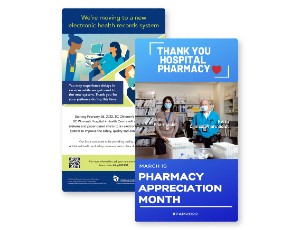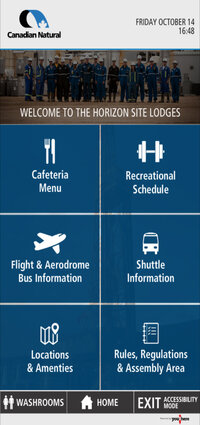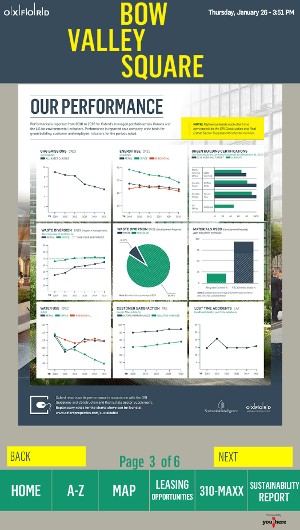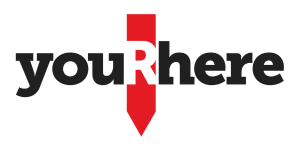Big changes are happening in the way we communicate within buildings and campuses. We’ve evolved from paper posters, expensive printed newsletters, and many ignored emails.
The latest and most sustainable trend is digital signage.
More traditionally known for their directory capabilities, digital signage hubs have now become portals of information — an essential part of direct messaging in a communal setting.
More Than a Directory
“A lot of people call our solution a digital directory, but the content that we put on our screens has evolved to be so much more,” says Scot Martin, President and CEO of youRhere.
Technology advancements such as the Internet of Things (IoT) now allow interactive information hubs to connect and pull data from many diverse sources, providing continually updated information to users.
“Think of these hubs as a virtual concierge or a one-stop shop for all information about the building, in a manner which is clear and helpful,” suggests Martin.
As we navigate a revolution into the digital age, buildings continue to look for ways to connect with multiple people quickly and with maximum engagement. This can also mean learning to communicate in a number of different languages, an especially critical factor, says Martin, in environments such as hospitals where timely access to information is essential.
“Canada is a very multi-cultural country. We have done some of our hubs in eight languages,” Martin explains, reflecting the demographics of the area served.
Before the introduction of flatscreen TVs, retailers would play advertising through looped video messaging on bulky analogue screens.
 The term “digital signage” is still relatively new, and is a concept which evolved quickly throughout the 2000s as the cost of large-format flatscreen technology became increasingly affordable.
The term “digital signage” is still relatively new, and is a concept which evolved quickly throughout the 2000s as the cost of large-format flatscreen technology became increasingly affordable.
Displayed in prominent, accessible locations, youRhere’s interactive digital touchscreens require a small amount of space to deliver a large quantity of information. For those on the move, the screens include third-party data such as real-time transit schedules, making getting around the city easier, something which is “particularly helpful in our climate” considering Canadian winters, notes Martin.
Countdown to Net-Zero
As Canada moves towards 2050’s net-zero initiatives, there is also a favourable cost impact of digital messaging compared to traditional paper notices.
“Having information presented to people digitally is certainly more sustainable than having a large number of plastic signage or paper posters all over the building,” says Martin. “You’ll have people who will put up posters all over a building to advertise Earth Day only to tear them down and throw them in the trash right after. We can deliver that with a touch of a button on a computer which will download the information to multiple screens. They can talk about what they are doing as a company, as a building manager, or as a facility, to reduce their carbon footprint.”
Digital technology also works to accommodate those with accessibility needs: youRhere’s digital touchscreens are set up at a height comfortable for a person either in a wheelchair or someone standing.
“Our screens also allow the user the ability to raise or lower the height of the on-screen menu through the touch of a button,” says Martin. And while a poster on a wall cannot provide someone with visual impairments the information they need, audio and braille options help those with vision issues successfully navigate through the building and gain confidence in their environment.
Delivering Analytics
“Messaging your audience can be a powerful tool,” Martin explains. “Every time you touch one of our screens it generates a piece of information. We collect this information and provide analytics to the building so they know how many people used the touchscreen and what they looked for. Our content management system is intuitive and menu-driven, therefore, you can judge the success of your campaign.”
 In a communal building setting, you have the briefest of times to entice your potential customer — mere milliseconds to engage as many senses as possible.
In a communal building setting, you have the briefest of times to entice your potential customer — mere milliseconds to engage as many senses as possible.
Building information hubs invite users to interact with their content using sight, sound and touch, and they are becoming more and more affordable
“Technology has enabled larger screens at lower prices,” says Martin. “We continually add features and functionality to our offering, and can put a tremendous amount of information in a small space — far more than if you put up a sign or a bulletin board.”
As advancements in technologies move towards gesture recognition and completely touchless screens, the trend upward will continue.
“Some buildings are very active — they are constantly refreshing the content on the screen and keep it engaging. It’s exciting to see people say, “Oh this is so much better than we thought it could be.”
Energy Conscious Messaging
With youRhere’s installed hardware focused on Energy Star certification, Martin encourages buildings to use the hubs to expand on the decarbonization initiatives each is taking.
 “Some companies will put a QR code on the screen and invite the user to download their annual ESG report,” he says. “We can put a QR code on every screen you pull up so theoretically we can link to anything.”
“Some companies will put a QR code on the screen and invite the user to download their annual ESG report,” he says. “We can put a QR code on every screen you pull up so theoretically we can link to anything.”
As competition for modern and futuristic designs in architecture opens the floor for new building developments, commercial and office tower clients are leading the way in championing digital signage solutions.
“In office towers, we’ve now reached to point where our solution is pretty much a standard feature—certainly for newly constructed buildings as well as substantial lobby renovations,” says Martin, who also noted that mixed-use properties, whether condo/hotel or office/retail, were also taking advantage of the information hub’s ability to communicate messaging to multiple audiences.
“We deliver a full turnkey solution,” says Martin. “Companies and clients that care about sustainability can use our screens to message their tenants, staff, and visitors to the building — all three audiences — and they can talk about what they are doing as a company, as a building manager, as a facility, to reduce their carbon footprint.”
The future is digital, touchable and engaging. Visit www.youRhere.ca to find your building’s communication solution.
Scot Martin is the CEO of youRhere, a leading provider of digital signage solutions
for commercial, retail, healthcare, and educational properties across Canada. For
more information, visit www.youRhere.ca.







